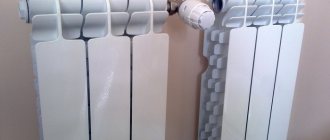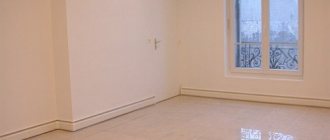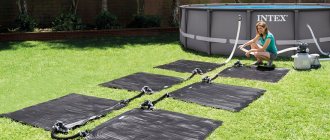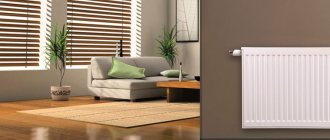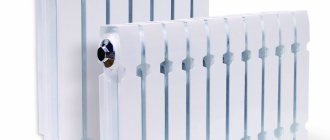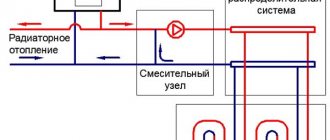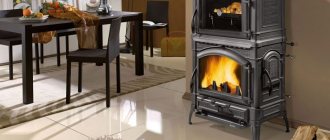An unusual heating technology, fundamentally different from the usual systems with radiators under the windows, came to us from European countries recently, although it has been used there for more than twenty years. The name of the innovation speaks for itself - warm baseboard, the demand for it is growing due to its technical advantages and modern design.
You will learn everything about the types of baseboard heating and the features of its operation by reading the article we have proposed. We will talk about the design specifics and rules for constructing all types of baseboard heating systems. Here you will find out where heating baseboards are used and which models are popular among consumers.
Heat power of Charley baseboard
Electric – 200 W/linear m.
Water – 220 W/linear m. at coolant temperature 70 degrees
An increase in coolant temperature leads to a proportional increase in power. For example, if the coolant temperature is 80 degrees, the system power will be 270 W/linear m. However, such indicators in central Russia are only possible if the temperature outside drops below 40 degrees. In this case, due to increased convection, the meaning of heating using baseboards is lost.
Power of liquid warm baseboard Charley
| Coolant inlet temperature | Coolant outlet temperature | Air temperature | Heat dissipation power: Standard | Heat dissipation power: Power |
| T, оС | T, оС | T, оС | Q, W/rm. m | Q, W/rm. m |
| 40 | 35 | 20 | 92 | 96 |
| 45 | 40 | 20 | 98 | 101 |
| 50 | 45 | 20 | 110 | 116 |
| 55 | 50 | 20 | 139 | 146 |
| 60 | 55 | 20 | 164 | 172 |
| 65 | 60 | 20 | 189 | 198 |
| 70 | 65 | 20 | 220 | 231 |
| 75 | 70 | 20 | 250 | 262 |
| 80 | 75 | 20 | 270 | 283 |
To operate a liquid warm baseboard, 0.26 liters of water per 1 meter of system is sufficient. Those. one complete circuit of a 12.5 m water baseboard heating system will require only 3.5 liters of coolant. And to heat a room of 100 sq.m. Only 8 liters of liquid will be enough.
Dimensions of warm skirting boards
- A – Warm baseboard height – 140 mm
- B – Depth of the product mounted on the wall – 30 mm
- C – Height of the heating module – 64 mm
- D – Copper tube diameter – 15 mm
- E – Heating module depth – 23 mm
- F – Maximum length of the heating module – 2000 mm
Thanks to the use in the design of the system of materials with a high thermal conductivity coefficient (anodized aluminum and copper), which are not subject to corrosion, Charley warm baseboards are guaranteed to be reliable and durable.
Installation of warm baseboard
For installation you will need tools: adjustable wrenches in a set, a drill with an impact function (or a hammer drill), a hammer, wire cutters, pliers, scissors (to cut plastic). A baseboard heating system can be quickly installed if the connection points are prepared in advance.
Even before purchasing the necessary equipment, you need to plan what power the heating elements need and how to place them around the perimeter of the room.
Assembling a water heating system
Stage 1. We measure the distance from the point where the distribution manifold will be located to the location of the baseboard. We cut two lengths of the protective pipe and two with an allowance of 20 cm for the connecting pipe. We insert the connector into the protective one, and seal the ends with adhesive tape to protect it from dirt.
Installation of a water baseboard heating system: red - main flow, blue - return. The return flow pipe must be located higher
Stage 2. We pull the pipes along the floor without tension so that if extensions are necessary, one or more can be laid nearby. We fix it with mounting tapes, cover it with a protective solution, protecting it from damage, and place it in the right place on the wall 6 cm above the floor and 10-15 cm from the edge of the wall or corner, fix it with cement.
Stage 3. After laying the finished floor, we continue work. We glue an insulating strip along the entire length. We stretch the aluminum edge (also along the entire length of the heating), covering the junction of the wall and the floor. Screw it or secure it with adhesive tape or silicone.
Stage 4. We lay a special profile along the top line, put holders on it at a distance of 15 cm from the corners and every 40 cm along the wall.
Stage 5. To connect heating pipes and heating elements, we use couplings with nuts, bushings and gaskets, in the corners - 90º corner rotary tubes, in the ends - 180º end rotary tubes and plugs. We connect the thermal sections with adapters.
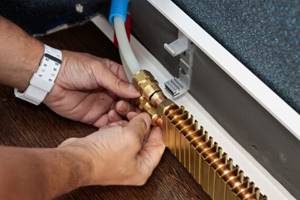
When connecting the heating module, you need to remove 2-3 lamellas from the edge and put connecting nuts, crimping parts, and rubber gaskets on the tubes
Stage 6. Carefully press the connected heating sections into the holders. We put on decorative panels (attach with screws or snap on) and decorative corner elements. We connect the system to the manifold, fill it with water, and test it at operating and maximum pressure.
Like all collector systems, the heating baseboard requires a circulation pump to stimulate the movement of the coolant. Without a pump, it is difficult for heated water to circulate along an extended circuit. However, the use of technical devices affects the overall cost of the system.
The plinth will work if all technological operations were performed without violations. If there is a leak, the problematic connections must be tightened with a wrench. The coolant is supplied through the collector by a circulation pump from the boiler or from a general (centralized) heating system.
Electric heating system assembly
For a warm baseboard, a separate circuit breaker must be made in the electrical panel. Its power is determined by the number of heating modules.
Stage 1. We supply power to the distribution box, which should be near the location of the system at a height of 4-6 cm from the floor.
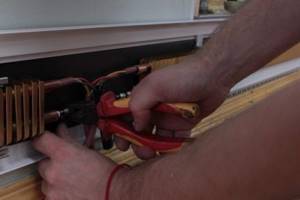
Installation of an electric heating system: most often, the electric system is used where it is possible to supply the required power, or in small rooms as additional heating
Stage 2. Apply insulating tape to the wall.
Stage 3. We install the lower aluminum profile (edge) and the upper one, onto which we attach holders at the same distance as for the water system - 15 cm from the corners and in increments of 40 cm along the wall. We install a remote thermostat. It should be located at a height of about 1.5 m opposite the system modules and at a distance of at least 2 meters from them.
Stage 4. We insert electric heating elements (heating elements) into the lower pipe of the heating module, fix the modules in the holders so that they do not touch the wall.
The electrical contacts of the heating elements have a thread, two nuts, a retaining ring on a spring, and a heat-shrinkable tube for additional insulation. The modules are connected in parallel using a heat-resistant power cable coated with silicone and heat-resistant up to 180°C.
Stage 5. We close the system with a plastic box from above.
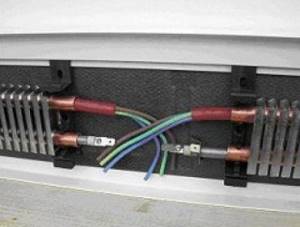
To connect heating modules, a 3-core cable is used: brown wire - phase, blue - zero, green (yellow) - ground. The cable must be grounded
It is best to entrust the connection of the installed heating system to the power supply to an electrical specialist. He will check the reliability of the insulation with measuring instruments, supply electricity and adjust the thermostats.
Complete set of Charley warm baseboard system
The system kit consists of:
- Heating energy module, which includes two copper tubes with aluminum fins with a diameter of 15".
- Aluminum case, which includes two strips: top and closing.
- Rear wall.
- Brackets necessary for attaching the heating module to the wall.
All materials used are absolutely safe for the environment. They do not have a harmful effect on the microclimate, do not emit fumes, and are odorless. Therefore, they are ideal for creating a comfortable atmosphere for people and pets.
To make the rooms not only warm, but also beautiful, the baseboard can be made in any of the color variations. Our specialists will paint the external elements of the system in any of the colors, or decorate them with stone, metal, marble or valuable wood.
How does baseboard heating work?
To create a system of warm baseboards, heating devices similar to low, long radiators are installed around the perimeter of the room at floor level. They are covered with decorative panels resembling a plinth. Thus, the heating system is hidden from view and does not interfere with the aesthetics of the room.
This heating method was used back in the last century: in old buildings you can find heating devices of this type. However, at that time the option was not widely used due to its high cost.
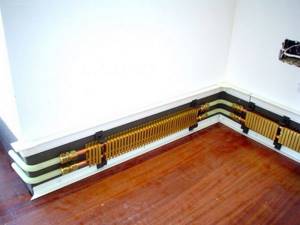
Now, installing such a heating system will also require more costs than installing conventional radiators, but it is simpler and cheaper than installing a heated floor, and in some cases, more profitable.
The heating device is based on two copper tubes mounted at a distance of up to 15 cm, one above the other. For better heat transfer, they are equipped with perpendicular metal plates, which can be made of aluminum, brass or copper. The structure is covered with an aluminum casing with upper and lower openings for better air exchange.
This design turns out to be extremely effective. Cold air coming from below heats up:
- from pipes and cross plates;
- metal body structure;
- heated walls.
This allows you to quickly and evenly heat the entire volume of the room from floor to ceiling.
How does it work, or why is thermal radiation more economical?
You probably know the situation when in February, under the first direct rays of the sun, it becomes warm, even when the air temperature is below zero. When you light a fire, you also observe this effect of heat rays. A Turkish bath works on the same principle: the air itself is not hot, but the steaming effect is achieved by the heat from the stone walls.
It is known that the most comfortable thing for a person is to stay in a room with warm walls and cool air. Being in an uninsulated house, even if the air temperature is heated to 20-22C, is uncomfortable: it does not leave a feeling of chilliness. To really warm up, you need to increase the temperature of the walls.
The baseboard heat system works exactly according to this scheme: the energy of the coolant is converted into thermal radiation. The heat generated by the heating element slowly rises along the surface of the walls, heating them. And the already warm walls heat the air in the room, nearby objects and people.
Since precious heat is not contained in the air, but in building structures and objects, it does not escape into the street when ventilated. And the oxygen concentration in the room does not decrease, because... it does not fade when heated. This ensures optimal humidity levels are maintained.
What should be the ideal heating system for a home?
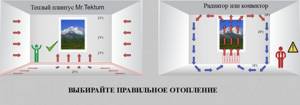
- Energy efficient and economical. The use of modern technologies should reduce energy costs as much as possible by reducing its consumption. At the same time, energy savings should not lead to a decrease in comfort for people living in an apartment or private house. A warm baseboard can heat a building with an area of 100 sq.m. using only 8 liters of coolant, which is significantly less than all systems known today.
- Durable and extremely reliable. Replacing heating system pipes at the height of the heating season is a very labor-intensive and expensive procedure. Repairing a water-heated floor system is especially difficult. Therefore, the reliability and maintainability of baseboard heat makes it the most profitable heating system today.
- With stable hydraulic characteristics. The system must be controllable and predictable in terms of coolant flows in the pipes. Warm baseboard meets all of the above characteristics.
Design, scope, price
Thin, elegant heaters that harmonize with the overall decor allow you to implement the most non-standard design ideas.
The peculiarity of the baseboard heating system is that it does not take away any free space from the room, and it can be placed next to furniture, antiques, household appliances, and musical instruments.
The material from which the flooring and walls are made also does not matter - there will be no damage or harm.
A palette of hundreds of colors and shades makes it possible to choose the appearance of the case to your liking. The texture can be a flat and smooth surface or an imitation of granite stone, marble, or wood.
A baseboard radiator will equalize the temperature in colder corner and end rooms; owners of cottages and country houses who want to create an elegant interior in their homes are interested in this technology. And in high-rise buildings, many people want to heat loggias and balconies, and this task is also easily solved using a similar heating scheme.
Wherever baseboard heating is used - in greenhouses and winter gardens, swimming pools and gyms, in museum buildings, concert halls, etc. Panoramic construction is in fashion, but you cannot install ordinary radiators along a wall that is solid glass.

A wide range of textures and shades of the warm baseboard body allows it to be used as a decorative element. In this case, it merged into a single whole with the door frames
Traditional heating also loses in rooms with high ceilings. No matter how much you heat them with radiators, warm air will still rush up to the ceiling, leaving the lower zone cool, and with the help of a thermal baseboard the situation can be easily corrected.
As for the price, the purchase and installation of heated baseboards is comparable to the cost of heated floors. Both will not be cheaper than installing a classic heating system with batteries.
Unfortunately, all energy-efficient devices cannot be called cheap, but the costs are worth it. In order not to overpay, you need to complete the system in advance - each of its elements has its own price. Only a specialist can do this correctly.
Reviews
“I have a baseboard like this at home. In addition to heated floors. I advise you to install it too. The warm baseboard does its job well. Of course, it cannot be compared with warm floors in terms of power, but still there is noticeable warmth from it.”
Nikolay, Moscow
“I installed heated floors and baseboards. I’ll say unequivocally: the price of the baseboard is cheaper, but I like it better for heating.”
Alexander, St. Petersburg
“I bought a Megador 600 W for a 9 m2 bedroom. At first it worked at full power, but now we set it to maintain 20 degrees at 200 W. This is enough for my area, we don’t need a higher temperature, we don’t like it. And at the same time, on the wall where the heater is located, our ventilation hole is almost always slightly open. I'm happy."
Pavel, Chekhov
As you can see, reviews about warm baseboards are positive. This is no wonder: the heating is efficient, comfortable, and even invisible. The only thing that spoils the picture is the high price, but there are options for making it yourself.
Which heating baseboard to choose for heating
When purchasing heated floors, you should pay attention to the product manufacturers. It is better to purchase skirting boards from well-known brands with a long history.
Among the manufacturers that have proven themselves to be of good quality equipment:
- "Mr. Tectum"
- "Rehau"
- "Besta Board".
When installing electric heated skirting boards, it is necessary to first assess the need for electricity consumption and the possibility of connecting the equipment to the network. An important factor determining the choice of heating baseboard is the material of the walls. The typical characteristics of the premises are also taken into account.
Installing a water baseboard
Having prepared a set of necessary tools, you can begin installing a warm water baseboard with your own hands. First you need to lay the coolant supply pipes. Installation begins from the corner where these tubes exit. To simplify the process, we have prepared detailed step-by-step instructions:
- Install the bottom bar.
- We eliminate the gap between the wall and the plank using sealant.
- We fix the bar with connecting materials.
- We glue thermal insulation material to the wall.
- The excess is cut off with a knife.
- We measure the required height of the plinth.
- We install the first holder at a distance of at least 15 cm from the corner.
- The remaining holders should be installed at a distance of 40 cm from each other.
- We screw the holders to the wall. If the material allows, this is done with self-tapping screws. Otherwise, for each holder you need to mark the places for drilling, drill holes, install dowels in them and only then screw the holder.
- We attach the remaining holders to the wall in the same way.
- We install all the planks and fasteners in those areas of the room where the warm baseboard will be installed.
- We install the necessary decorative elements and adjust the holders.
- We lay out the radiators on the floor and measure the required distance.
- If some areas of the room are shorter than the length of the radiator, you can cut it and remove some links to simplify the work.
- We begin connecting the system from the coolant supply point. We put on fittings and gaskets for connection.
- We connect the radiator to the coolant supply system.
- Tighten the fittings with wrenches.
- We attach the radiator to the holders.
- We connect the radiator sections to each other, having previously installed the connecting elements.
- At the end sections, the radiator tubes are closed with rotating hoses.
- After completion, the first start-up of the system is carried out and the presence of leaks is checked. If they are detected at the joints, they are eliminated by tightening them more tightly with wrenches.
- If the commissioning work has shown that the system is in good working order and is ready for use, you can complete the work by installing the decorative front panel.
- Heat-insulating tape is glued to the inside of the decorative element. It prevents overheating and allows heated air to escape.
- The front panel is mounted on a prepared base.
- For reliability, it must be attached with self-tapping screws.
- The protruding parts of the screws are hidden under the plugs.
It seems that the procedure is too complicated, but in fact, every person who has previously used wrenches and a screwdriver can handle it.
A detailed analysis of the preparatory work and installation of the plinth can be seen in this video:
Advantages and disadvantages: truth and fiction
Since some of the advantages of these systems declared by the manufacturer are a marketing ploy, we will list them with our reasoned comments:
Thermal skirting boards warm the room with healthy infrared heat coming from the walls.
Judging by the data presented, the wall is heated by the flow of air passing through heat exchangers, which are real baseboard convectors. The temperature of the walls at different points is 26-30 ºС, and with such heating the radiant component is negligible; this requires a higher surface temperature. This means that the room is simply warmed up evenly from the flow of warm air rising along all the walls, as well as from the radiators.
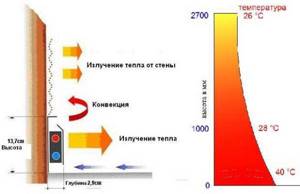
Baseboard heating is efficient and economical due to the low temperature of the coolant.
The statement about efficiency is contradictory from a logical point of view. According to the manufacturer, there is an intermediary between the heater and the room - the wall. Can the efficiency of the system increase by adding an intermediary to it? Since it is known from practice that baseboard-type heating can quite successfully heat a house, the conclusion arises that there is no intermediary in the form of a wall. Convectors above the floor simply heat the air, as stated in the previous paragraph.
If the declared heat transfer indicators are correct, then the statement about efficiency is true. A simple example: a 4 x 5 m room with an area of 20 m2 and a perimeter of 18 m requires 2 kW of thermal energy. 17 m of thermal baseboard will give 17 x 200 = 3400 W or 3.4 kW (we subtracted the width of the doorway from the perimeter). The heat released is one and a half times more than required, which means that the temperature of the coolant can be reduced from 65 ºС to 40 ºС, and this is a saving.
No mold or dampness.
The presence of fungi in the house depends to a greater extent on supply and exhaust ventilation rather than on heating. The statement is incorrect.
The system warms up the lower zone of the room well, as well as heated floors.
The statement is true, aluminum boxes emit infrared heat to the feet, which is very comfortable for people.
Fits perfectly into any interior.
Indeed, a plinth box for heating pipes looks great in a room for any purpose. The only caveat is that the cabinet furniture gets in the way; you won’t be able to get around it. We will not discuss another statement about the absence of dust sublimed by the convective movement of air from traditional heating systems, since this system is also convective. But overall, this new type of heating deserves attention because it meets the highest requirements for interior design and takes up absolutely no space.

One problem, which is also the only drawback, is the significant cost of heating and distribution equipment, as well as its installation. It should be noted that baseboard heating pipes are almost the most expensive of all existing water systems.
